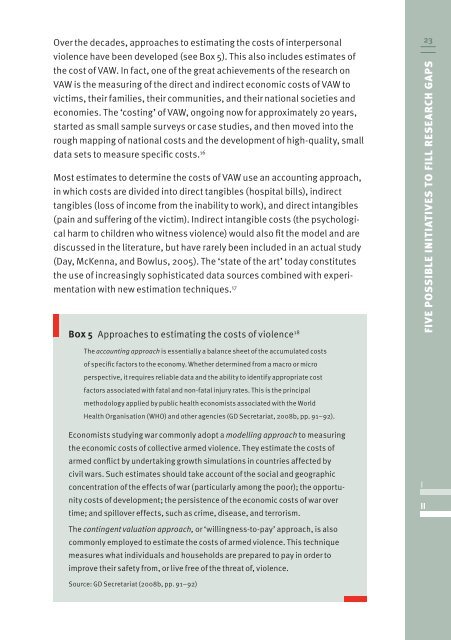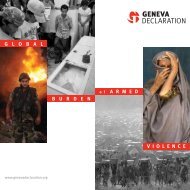Tackling Violence against Women: From Knowledge to Practical
Tackling Violence against Women: From Knowledge to Practical
Tackling Violence against Women: From Knowledge to Practical
You also want an ePaper? Increase the reach of your titles
YUMPU automatically turns print PDFs into web optimized ePapers that Google loves.
Over the decades, approaches <strong>to</strong> estimating the costs of interpersonal<br />
violence have been developed (see Box 5). This also includes estimates of<br />
the cost of VAw. In fact, one of the great achievements of the research on<br />
VAw is the measuring of the direct and indirect economic costs of VAw <strong>to</strong><br />
victims, their families, their communities, and their national societies and<br />
economies. The ‘costing’ of VAw, ongoing now for approximately 20 years,<br />
started as small sample surveys or case studies, and then moved in<strong>to</strong> the<br />
rough mapping of national costs and the development of high-quality, small<br />
data sets <strong>to</strong> measure specific costs. 16<br />
Most estimates <strong>to</strong> determine the costs of VAw use an accounting approach,<br />
in which costs are divided in<strong>to</strong> direct tangibles (hospital bills), indirect<br />
tangibles (loss of income from the inability <strong>to</strong> work), and direct intangibles<br />
(pain and suffering of the victim). Indirect intangible costs (the psychological<br />
harm <strong>to</strong> children who witness violence) would also fit the model and are<br />
discussed in the literature, but have rarely been included in an actual study<br />
(Day, Mckenna, and Bowlus, 2005). The ‘state of the art’ <strong>to</strong>day constitutes<br />
the use of increasingly sophisticated data sources combined with experimentation<br />
with new estimation techniques. 17<br />
Box 5 Approaches <strong>to</strong> estimating the costs of violence 18<br />
The accounting approach is essentially a balance sheet of the accumulated costs<br />
of specific fac<strong>to</strong>rs <strong>to</strong> the economy. whether determined from a macro or micro<br />
perspective, it requires reliable data and the ability <strong>to</strong> identify appropriate cost<br />
fac<strong>to</strong>rs associated with fatal and non-fatal injury rates. This is the principal<br />
methodology applied by public health economists associated with the world<br />
Health Organisation (wHO) and other agencies (gD Secretariat, 2008b, pp. 91–92).<br />
Economists studying war commonly adopt a modelling approach <strong>to</strong> measuring<br />
the economic costs of collective armed violence. They estimate the costs of<br />
armed conflict by undertaking growth simulations in countries affected by<br />
civil wars. Such estimates should take account of the social and geographic<br />
concentration of the effects of war (particularly among the poor); the opportunity<br />
costs of development; the persistence of the economic costs of war over<br />
time; and spillover effects, such as crime, disease, and terrorism.<br />
The contingent valuation approach, or ‘willingness-<strong>to</strong>-pay’ approach, is also<br />
commonly employed <strong>to</strong> estimate the costs of armed violence. This technique<br />
measures what individuals and households are prepared <strong>to</strong> pay in order <strong>to</strong><br />
improve their safety from, or live free of the threat of, violence.<br />
Source: gD Secretariat (2008b, pp. 91–92)<br />
23<br />
FiVE PossiBlE iNiTiATiVEs To Fill REsEARcH GAPs<br />
i<br />
ii









